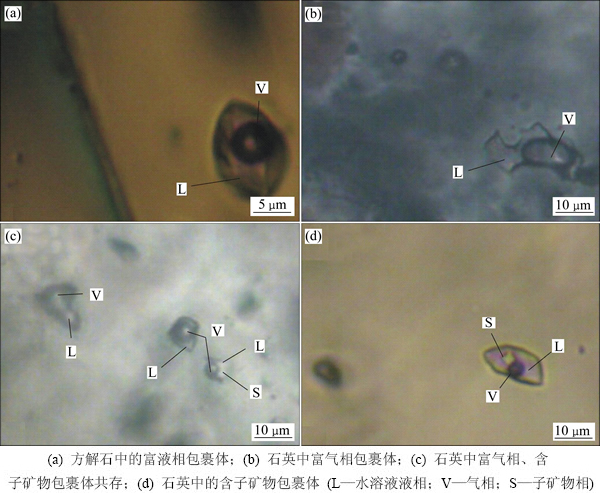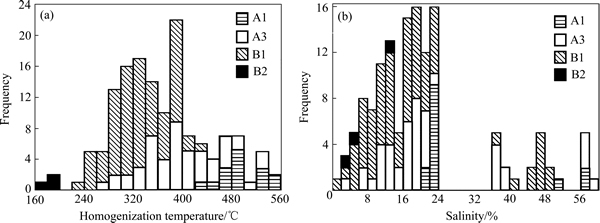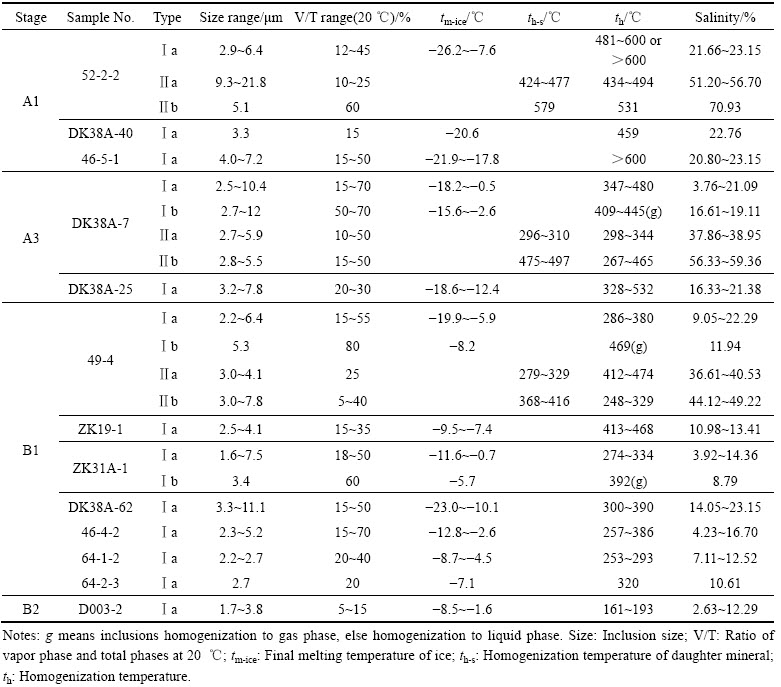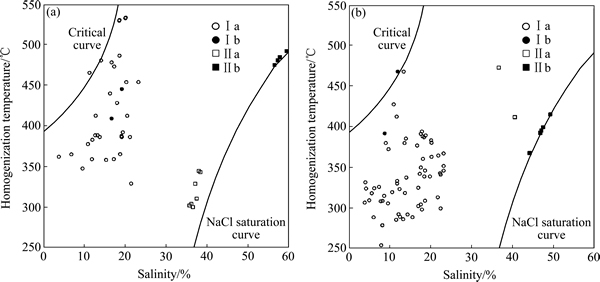文章编号:1004-0609(2015)10-2871-12
铜陵老鸦岭铜矿床流体包裹体特征与成矿作用
徐方颖1, 2,赖健清1, 2,王雄军1, 2
(1. 中南大学 有色金属成矿预测教育部重点实验室,长沙 410083;
2. 中南大学 地球科学与信息物理学院,长沙 410083)
摘 要:老鸦岭铜矿床是安徽省铜陵冬瓜山矿田内的一个矽卡岩型矿床。矿体赋存于远离主接触带的下二叠统到下三叠统大理岩地层中。原生成矿过程分为矽卡岩期的早矽卡岩阶段(A1)、晚矽卡岩阶段(A2)、氧化物阶段(A3)和热液期的石英硫化物阶段(B1)、碳酸盐阶段(B2)。包裹体岩相学分析表明:石榴子石、透辉石、石英和方解石中发育着气液两相包裹体(Ⅰ型)和含子矿物包裹体(Ⅱ型)。显微测温结果显示:早矽卡岩阶段,包裹体均一温度为434~579 ℃或者>600 ℃,盐度连续分布在20.80%~56.70%,显示其成矿流体具有高温、高盐度的特征,体系处于超高压环境;氧化物阶段,流体减压沸腾,最低沸腾温度为298 ℃,包裹体具有不均一捕获特征,地下水的混入导致盐度从59.36%到3.76%显著变化,由于处于开放体系,受静水压力影响,估算成矿压力范围为16~37 MPa,结合上覆地层的厚度判断成矿深度约为1.6 km;石英硫化物阶段,包裹体均一温度集中于250~350 ℃,盐度在3.92%到49.22%之间;碳酸盐阶段,包裹体均一温度为160~193 ℃,盐度为2.63%~4.39%,成矿流体显示出从高温到低温、从高盐度到低盐度、从均一到不混溶分离的演化过程。基于以上研究,推断老鸦岭铜矿床的成矿流体以高温、高盐度的岩浆流体为开端,在上侵和沿大隆组地层快速运移过程中逐渐演化,伴随沸腾作用和两次地下水的混入,成矿流体温度、盐度、压力不断下降,最终在青山脚背斜轴部卸载成矿。
关键词:流体包裹体;成矿流体;铜矿床;成矿作用;矽卡岩
中图分类号:P611.1 文献标志码:A
Characteristic of fluid inclusions and metallization of Laoyaling copper deposit in Tongling, Anhui Province, China
XU Fang-ying1, 2, LAI Jian-qing1, 2, WANG Xiong-jun1, 2
(1. Key Laboratory of Metallogenic Prediction of Nonferrous Metals, Ministry of Education,
Central South University, Changsha 410083, China;
2. School of Geosciences and Info-Physics, Central South University, Changsha 410083, China)
Abstract: The Laoyaling copper deposit, located at the Dongguashan mining area, Tongling, Anhui Province, China, is a skarn deposit. The orebodies are mainly located in the marble of the Lower Permain to the Lower Triassic strata, which is far from the contact zone. The primary ore-forming process is divided into skarn period and hydrothermal period. The former period can be subdivided into early skarn stage(A1), late skarn stage(A2) and oxide stage(A3), and the latter period can be subdivided into quartz sulfide stage(B1) and carbonate stage(B2). The characteristic of ore-forming fluids and mineralization were discussed by petrographical and micro thermometric data of the fluid inclusion. Two types of inclusions, gas-liquid two-phase aqueous inclusions (type Ⅰ) and aqueous inclusions with daughter mineral (type Ⅱ), are hosted in garnet, diopside, quartz and calcite. The inclusions of early skarn period homogenize at temperatures of 434-579 ℃ or >600 ℃ and have salinities of 20.80%-56.70%, indicating that the ore-forming fluids in this stage have the characteristics of high temperature, high salinity, and ultrahigh pressure. The oxide period, owing to the decrease of pressure, ore-forming fluids started to boil at the lowest temperature of 298 ℃, which shows the characteristics of heterogeneous capture of inclusions, and changes the salinity from 59.36% to 3.76% obviously by inburst of groud water. The system is affected by the hydrostatic pressure in the open system with metallogenic pressure changing from 16 MPa to 37 MPa, together with thickness of the overly strata, the metallogenic depth is deduced to be 1.6 km. The inclusions of quartz-sulfide period homogenizing at temperature of 250-350 ℃ have salinities of 3.92%-49.22%, and in carbonate period homogenizing at temperatures of 160-193 ℃, the inclusions have salinities of 2.64%-4.39%. The results demonstrates that the ore-forming fluids evolve from high-temperature to low-temperature, from high-salinity to low-salinity and from homogenization to immiscible separation. The ore-forming fluid is originated from different evolutional stages of the primitive fluids derived from the magmatic intrusion, and started with characteristics of high temperature and high salinity. The ore-forming components were precipitated in Qingshanjiao anticline due to twice boiling and fluid mixing as well as the decrease in salinity, temperature and pressure of the fluids.
Key words: fluid inclusion; ore-forming fluid; copper deposit; metallogenesis; skarn
冬瓜山矿田(前人所称的狮子山矿田)是铜陵地区乃至长江中下游地区矿化蚀变作用持续时间较长、成矿规模较大、研究程度较高的重要矿区。在近5 km2范围内铜矿体成群产出[1],深部的冬瓜山矿床,中部的花树坡矿床、大团山矿床,上部的老鸦岭矿床、西狮子山矿床和浅部的东狮子山矿床沿接触带自下而上呈阶梯状排列,形成了“多层楼”的矿床空间分布模式[1-2]。在平面上,老鸦岭矿床在北端与冬瓜山矿床毗邻,东北侧与大团山矿床、东狮子山矿床、西狮子山矿床接壤。
不同于其它矿床,老鸦岭铜矿床是一个远离接触带产出的,以铜矿为主、伴生有金-钼的层控矽卡岩型矿床,矿体多产于大理岩地层中[3-4],有关此矿区的研究鲜见报道。杨刚等[3]对矿床中含钼碳质页岩进行Re-Os同位素(ICP-MS法)定年,发现其等时线年龄(234.2±7.3 Ma)与地层沉积年龄相近;杨学明等(1997)[4]对矿床内方铅矿和黄铁矿进行的微量元素测试,表明两者受后期热液改造,已不具备沉积特征;而在成矿流体方面,前人的研究几乎空白,制约了整个矿区成矿流体特征与演化及成矿作用的系统研究。本文作者通过对老鸦岭铜矿床内,不同深度、不同成矿阶段、不同类型的包裹体进行岩相学和显微测温研究,查明各阶段包裹体的基本类型,探讨成矿流体的来源、性质、演化过程,为研究成矿作用提供依据。
1 地质背景
铜陵地区处于华南板块的东北缘,扬子板块和华北板块的结合部[5-8],大别造山带的前陆褶断带上(见图1)。区内复杂的演化过程可分为基底形成阶段、盖层发育阶段和板内变形阶段[1, 9-11]。区域褶皱变形基底由一套变质岩组成,可分为“江南型”和“江北型”,铜陵矿集区的基底就处在这两类基底的分界线上[10];盖层发育阶段,区域上广泛发育浅海相碳酸盐岩沉积建造[12],受加里东运动和海西运动的影响,铜陵地区在志留纪末期上升成陆,接受风化剥蚀,普遍缺失中下泥盆统和下石炭统地层,在晚泥盆世重新接受沉积,形成区域上了沉积间断面[11];中侏罗世到晚白垩世,燕山运动引发大规模的陆内构造-岩浆-成矿活动,壳幔混合型中酸性岩浆侵位,形成了各种类型的矿床。伴随着燕山运动,铜陵矿集区如今的主体面貌才慢慢形成[11]。
铜陵矿集区出露地层从志留系到第四系,岩性表现为陆相砂岩→海相碳酸盐岩→陆相砂岩;区域构造呈现多期、多时代、多层次和多性质的特点[13];区域岩浆活动十分强烈,侵入岩以中晚侏罗世-白垩纪的中酸性岩为主,也可见喷出岩[1, 11-12];矿集区内的主要矿产有铜、铁、铅锌、金、硫、钼、钨、锑等[14],铜矿点众多而集中,矿床类型多样,以矽卡岩型和斑岩型为主。
冬瓜山矿田主要出露三叠系地层,岩性以灰岩和白云岩为主(见图2),其中下三叠统在青山脚背斜轴部发育大量矽卡岩、大理岩[13]。深部探矿工程还揭露泥盆系五通组(D3w),石炭系黄龙组(C2h)和船山组(C3c),二叠系栖霞组(P1q)、孤峰组(P1g)、龙潭组(P2l)和大隆组(P2d)地层,地层间多为整合接触[14]。
青山背斜是区内的主要褶皱构造,全长22.5 km,宽约8 km,为一短轴不对称褶曲[1, 11-12, 14];区内断裂构造发育,可分为成矿前断裂和成矿后断裂[13],与旁侧派生裂隙形成特有的网格状构造系统,控制着矿区内岩浆岩的分布和矿化作用。

图1 铜陵矿区区域位置图[11]
Fig. 1 Regional geological map of Tongling district[11] (YCF: Yangxin-Changzhou fault; XGF: Xiangfan-Guangji fault; TLF: Tancheng-Lujiang fault)
矿区侵入岩以燕山期花岗闪长岩、石英二长闪长岩、辉石二长闪长岩为主,多呈岩株、岩墙、岩枝状等小侵入体产出,在不同水平面上相互沟通,构成浅成相侵入岩系[13]。
2 矿体地质特征
老鸦岭铜矿床是一个远离主接触带赋存于围岩中的矽卡岩型矿床[15],由100多个小矿体组成,严格限制在下二叠统到下三叠统地层内,呈多层产出。矿体位于青山背斜的轴部,其产状和形态变化受褶皱影响[4],轴部产状平稳,NW和SE翼产状分别为50°~80°、10°~30°,与地层产状一致[4]。
矿体总体走向为NNE-NE向,一般的矿体呈层状、似层状和透镜体状展布,沿走向延伸400 m左右,斜深150~300 m。D-1矿体为最大的主矿体,向东侧伏,存在局部收缩和膨胀现象[3-4],沿走向延伸1117 m,宽100~600 m,厚1.4~40 m(平均7.8 m),平均含铜1.57%[4]。
燕山期岩浆侵入作用造成了矿区内较大范围的围岩(接触)热变质,使上石炭统-二叠统的地层变质为矽卡岩、大理岩、白云质大理岩,矿体就产在远离侵入岩体的大理岩地层中。与成矿密切相关的蚀变作用还有硅化、碳酸盐化、绿泥石化、绿帘石化等。
矿石中主要金属矿物有磁铁矿、黄铜矿、磁黄铁矿、黄铁矿,可见少量闪锌矿、方铅矿。非金属矿物有石榴石、透辉石、普通角闪石、透闪石、阳起石、黑云母、绿帘石、绿泥石、白云母、石英、长石、方解石等。
矿石结构主要有自形-半自形粒状结构、交代残余结构、固溶体分离结构、填隙结构、反应边结构;构造主要有块状构造、(网)脉状构造、浸染状构造、角砾状构造。
根据矿脉穿插关系及矿物组合、矿石结构特征,结合前人的研究成果,老鸦岭矿床的原生成矿过程可划分为矽卡岩期(A)和热液期(B)。矽卡岩期又可细分为早矽卡岩阶段(A1)、晚矽卡岩阶段(A2)和氧化物阶段(A3);热液期分为石英-硫化物阶段(B1)和碳酸盐阶段(B2)。
矽卡岩期:主要形成石榴子石(图3(a))、透辉石、透闪石(见图3(b))、绿帘石等矽卡岩矿物,晚矽卡岩阶段和氧化物阶段,分别以出现磁铁矿和石英(见图3(c)和(d))为特征。
热液期:石英硫化物阶段出现大量的金属硫化物,可见黄铜矿(见图3(c)和(d))、磁黄铁矿(见图3(c)和(d))、黄铁矿(见图3(d))填隙交代早期磁铁矿,也可见少量的方铅矿、闪锌矿,非金属矿物以石英为主,少数含方解石;碳酸盐阶段出现大量的方解石,矿化减弱,只生成少量星点状的黄铁矿生成。

图2 冬瓜山矿区地质简图[1]
Fig. 2 Geologic map of Dongguashan deposit (modified from Ref.[1]) (1—Quaternary; 2—Middle Triassic; 3—Lower Triassic; 4—Hornfels; 5—Granodiorite; 6—Quartz monzodiorite; 7—Pyroxene monzodiorite; 8—Granite porphyry; 9—Stratigraphic boundary; 10—Contact metamorphism boundary; 11—Fault; 12—Orebody)
3 流体包裹体特征
3.1 包裹体岩相学特征
选择不同中段及钻孔中的13件代表性样品磨制成双面抛光的测温片,厚度约60~80 μm,样品特征见表1。在透/反射显微镜下进行包裹体岩相特征研究,并确定显微测温对象。岩相学研究表明:在两个成矿期A1、A3、B1、B2这4个成矿阶段的石榴子石、透辉石、石英和方解石中发现流体包裹体。根据室温(20 ℃)下的包裹体形态,可细分为气液两相包裹体(Ⅰ型)、含子矿物包裹体(Ⅱ型)两类。其中Ⅱ型包裹体主要出现于A1、A3、B1阶段的石榴子石和石英中。
Ⅰ型包裹体:室温下由电解质水溶液和气泡构成。按其均一特征又可分为Ⅰa型(富液相水溶液包裹体) 和Ⅰb型包裹体(富气相水溶液包裹体)。Ⅰa型包裹体发育在石榴子石(A1阶段)、透辉石(A1阶段)、石英(A3、B1、B2阶段)和方解石(A3、B1阶段)中,以椭圆形和不规则为主,通常个体不大,直径一般小于8.5 μm,气相比为20%~60%(见图4(a)),升温后均一为液相;Ⅰb型包裹体发育在石英(A3、B1阶段)、方解石(A3阶段)样品中,为不规则、椭圆形和近四边形,直径最大可达12.0 μm,气相比50%~90%(见图4(b)),升温均一为气相。

图3 老鸦岭矿床主要矿物及其交生关系显微特征
Fig. 3 Microphotographs of minerals in Laoyaling deposit: (a) Garnet filled with carbonate minerals; (b) Crystal structure of plagioclase; (c) Magnetite replaced by chalcopyrite and chalcopyrite replaced by pyrrhotite; (d) Coexistence of chalcopyrite and pyrrhotite and pyrite, chalcopyrite and pyrite replaced by pyrrhotite (Grt—Garnet; Tr—Tremolite; Mag—Magnetite; Py—Pyrite; Ccp—Chalcopyrite; Po—Pyrrhotite; Py—Pyrite)
表1 样品采样位置及特征
Table 1 Locations and characteristics of samples

Ⅱ型包裹体:室温下由盐水溶液、气泡和子矿物构成的三相包裹体,多呈椭圆形和不规则状,直径一般小于8.0 μm,个别达到21.8 μm,气相比在25%左右,并与Ⅰb型包裹体共生(见图4(c)和(d))。大多数子矿物为1.0~1.4 μm的无色透明石盐立方晶体。根据升温时子矿物和气泡的消失情况,将其分为两个亚类:Ⅱa型包裹体在升温过程中子矿物先消失,然后气泡消失达到气液均一;Ⅱb型包裹体在升温过程中气泡先消失,而后子矿物熔化达到均一。
3.2 包裹体显微测温方法
包裹体显微测温工作在中南大学有色金属成矿预
测教育部重点实验室完成,测试所用仪器为Linkam THMS-600型地质用冷热台,测温范围在-196~600 ℃之间,经标准人工包裹体校准,-196~30 ℃范围内精度为±0.1 ℃,30~600 ℃范围内为±1 ℃。设置温度变化速率一般为10~30 ℃/min,在相变点附近,按需要设置为0.1~1 ℃/min。
通过显微冷热台测定了水溶液包裹体的冻结温度Tf、冰的初始熔化温度Ti、冰的最终熔化温度 、子矿物熔化温度
、子矿物熔化温度 和气液均一温度Th。利用BROWN (1989)[16]的FLINCOR计算机程序,采用BROWN和LAMB(1989)[17]等式计算出流体包裹体的盐度、密度、均一压力等参数。
和气液均一温度Th。利用BROWN (1989)[16]的FLINCOR计算机程序,采用BROWN和LAMB(1989)[17]等式计算出流体包裹体的盐度、密度、均一压力等参数。
3.3 包裹体显微测温结果
本研究工作对13件样品进行冷冻法和均一法测温工作,共测得150个主要类型的流体包裹体,包括Ⅰa型包裹体117个、Ⅰb型包裹体8个、Ⅱa型包裹体11个、Ⅱb型包裹体14个,测试及计算结果按照不同的成矿阶段及包裹体组合类型统计如表2,并分别制作了均一温度和盐度统计直方图(见图5(a) 和(b))。

图4 老鸦岭铜矿床流体包裹体显微照片
Fig. 4 Microphotographs of fluid inclusions in Laoyaling deposit: (a) Liquid-rich aqueous inclusion in calcite crystal; (b) Vapor-rich aqueous inclusion in quartz; (c) Vapor-rich aqueous inclusion and inclusion with daughter mineral in quartz; (d) Aqueous inclusion with daughter mineral in quartz (L—Liquid phase; V—Vapor phase; S—Daughter mineral)

图5 不同阶段包裹体的均一温度和盐度
Fig. 5 Homogenization temperature and salinities of fluid inclusions at different mineralization stages
3.3.1 矽卡岩期流体包裹体特征
A1阶段:包裹体发育在石榴子石和透辉石中,类型以Ⅰa型为主,偶可见Ⅱa型和Ⅱb型。Ⅰa型包裹体:除4个包裹体的气液均一温度超过冷热台测量温度的上限600 ℃外,其余均一温度在459~560 ℃(平均温度519 ℃),盐度为20.80%~23.15%(平均值为20.76%(质量分数)),均一压力在46~125 MPa,流体密度为0.561~0.735 g/cm3;Ⅱa型包裹体升温后子矿物先熔化,熔化温度为424~477 ℃(平均温度462 ℃),反映流体盐度为51.20%~56.70%(平均54.78%),而后气泡消失,温度在434℃~494℃(平均473℃),均一压力介于37~104 MPa之间,流体密度为1.101 ~1.134 g/cm3;Ⅱb型包裹体只在石榴子石中测得一组数据,升温后气泡先消失,气液均一温度为531 ℃,而后子矿物熔化,熔化温度为579 ℃,反应流体盐度为70.93%,按照子矿物熔化温度计算的均一压力为365 MPa,流体密度为1.331 g/cm3。
A3阶段:包裹体发育在石英和方解石中,富液相(Ⅰa型、Ⅱ型)和富气相(Ⅰb型)包裹体共存,气相比连续变化,为不均一捕获包裹体组合特征。Ⅰa型包裹体的均一温度为328~532 ℃,盐度介于3.76%~21.38%,均一压力为10~80 MPa,流体密度为0.546~0.904 g/cm3;Ⅰb型包裹体的均一为气相,均一温度为409~445 ℃,盐度介于16.61%~19.11%之间,均一压力为30~42 MPa,流体密度为0.750~0.851 g/cm3;Ⅱa型包裹体升温后子矿物先熔化,其温度介于296~310 ℃,反映流体盐度为37.86%~38.95%,而后气泡消失,气液均一温度为298~344 ℃,均一压力为16~37 MPa,流体密度为1.088~1.092 g/cm3;Ⅱb型包裹体升温后气泡先消失,气液均一温度为267~465 ℃,而后子矿物熔化,其温度介于475~497 ℃,反映流体盐度为56.33%~59.36%,均一压力为337~579 MPa,流体密度为1.152~1.335 g/cm3。
3.3.2 热液期流体包裹体特征
B1阶段:包裹体发育在石英和方解石中,仍以Ⅰa型包裹体为主,Ⅱb型包裹体次之,偶而可见Ⅰb型、Ⅱa型包裹体。Ⅰa型包裹体的均一温度为253~468 ℃,盐度介于3.92%~23.15%,均一压力为4~50 MPa,流体密度为0.558~0.938 g/cm3;Ⅰb型包裹体只测得两组数据,且均一温度的值相差较大,分别为469 ℃和392 ℃,盐度分别为11.94%和8.79%,均一压力分别为50 MPa和25 MPa,流体密度分别为0.515 g/cm3和0.637 g/cm3;Ⅱa型包裹体的数量较上阶段减少,也只测得两组数据:升温后子矿物先熔化,温度分别为329 ℃和279 ℃,反应流体盐度分别为40.53%和36.63%,而后气泡消失,气液均一温度分别为412 ℃和474 ℃,均一压力分别为16 MPa和36 MPa,流体密度分别为1.085 g/cm3和1.095 g/cm3;Ⅱb型包裹体升温后气泡先消失,气液均一温度介于248~329 ℃,而后子矿物熔化,温度为368~416 ℃,反应流体密度为44.12%~49.22%,均一压力为220~360 MPa,流体密度为1.182~1.241 g/cm3。
B2阶段:仅采集一个石英样品,且包裹体发育很少,只测得3组Ⅰa型包裹体均一温度为161~193 ℃(平均180 ℃),盐度介于2.63%~12.29%(平均值为6.44%)之间,均一压力在0.6~0.11 MPa,流体密度为0.905~0.967 g/cm3。
表2 流体包裹体显微测温结果统计表
Table 2 Micro-thermometric data of fluid inclusions in Laoyaling deposit

4 分析与讨论
本次工作共获得老鸦岭铜矿床的129组气液均一温度-盐度数据对,其中A1阶段包裹体11组,A3阶段包裹体44组,B1阶段包裹体71组,B3阶段包裹体3组,绘制A3、B1阶段完全均一温度-盐度关系图(见图6)。不同成矿阶段的流体包裹体类型、均一温度、盐度等具有一定的差异,反映了成矿流体的演化规律。
4.1 成矿流体特征及其演化
A1阶段。流体总体属于高温、中高盐度的流体,这种流体的形成机制,有研究者[18-23]将其概括为两种:1) 由中酸性岩浆分异出的高盐度独立流体;2) 由中低盐度热液通过液态不混溶作用或减压沸腾而来。第二种情况下,成矿流体中的包裹体应以含子矿物包裹体和富气相包裹体密切共生为特点。本研究中,A1阶段为高盐度含子矿物包裹体(Ⅱ型)和中高盐度富液相包裹体(Ⅰa型)共存,缺乏富气相包裹体(Ⅰb型)。因此,A1阶段成矿流体来源于岩浆期后残余溶液,均一温度为434~579 ℃或者>600 ℃,盐度为22.76%~23.15%和51.20%~56.70%两群。考虑到盐度大于23%可能存在水石盐或准稳态超饱和溶液[24],无法测出真实的盐度,故认为流体的盐度还是连续变化的,A1阶段的流体呈高温、高盐度的特征。由于不存在沸腾作用,包裹体的气液均一温度代表流体温度的下限[25],成矿温度展现从高温(>600 ℃)开始自然降温的过程。一个Ⅱb型包裹体估算的流体压力达365 MPa,大大超出了矿床上覆地层1.5~2.2 km[1]所对应的静岩压力为43~59 MPa(取大陆岩石平均密度值2.70 g/cm3),说明A1阶段存在超高压的环境。

图6 A3和B1阶段包裹体完全均一温度-盐度关系图
Fig. 6 Relationship of homogenization temperatures-salinities of fluid inclusions at A3(a) and B1(b) stages
A3阶段。流体从高温、高盐度开始演化。最初出现的Ⅱb型包裹体反映NaCl饱和水溶液被矿物捕获的过程,水溶液的温度高达475~497 ℃,盐度高达56.33%~59.36%,估算的最低压力值达到337~579 MPa。但这种饱和溶液很快被不饱和流体所取代,留下Ⅱa型包裹体,并与Ⅰb型富气相包裹体共存,反映高盐度流体的沸腾现象[26]。沸腾流体的盐度(37.86~ 38.95%)已明显低于沸腾前流体的盐度,说明流体沸腾的同时混入了低盐溶液。按照Ⅱa和Ⅰb型包裹体的最低均一温度估算的沸腾发生的温度为298 ℃,压力也降到16 MPa。随着低盐流体的不断混入,流体的盐度不断降低,但仍维持沸腾状态。
B1阶段。该阶段仍以高温、高盐度的流体为开端。含子矿物包裹体以Ⅱb型为主,盐度为44.12%~ 49.22%、完全均一温度(子矿物熔化温度)为368~416 ℃,计算的均一压力值在220~359 MPa之间,暗示着B1阶段的流体同样存在局部超高压。该阶段测得两个Ⅰb型富气相包裹体,可能反映出现短暂的沸腾现象。但这种现象很快就被稍低温度(集中于250~350℃之间)和盐度(3.92%~23.15%)的流体所取代,可能说明初期的超高压造成了液压致裂引起压力的骤降和流体沸腾,同时引起低盐度地下水的大量涌入,降低了温度和盐度,并压制了流体的沸腾。
B2阶段,即碳酸盐阶段。伴随成矿流体中金属离子的卸载,成矿进入末期,流体温度、盐度降低到161~193℃和2.63%~4.39%,显然已演化为中低温、低盐度流体。
4.2 温度、压力与深度估算
卢焕章等[25]认为:从均匀流体中捕获的包裹体的均一温度、压力仅能代表流体温度、压力的下限,需进行压力校正;而当流体发生沸腾作用时,流体内、外压相等,包裹体的均一温度、压力即为成矿的温度和压力,无需校正。
如前所述,A3阶段,Ⅱb型包裹体的估算最低压力值(337~579 MPa)反映了此阶段以超高压为开端,压力超过岩石抗张强度,液压致裂导致流体减压沸腾。此后,流体处于开放体系,存在沸腾特征,沸腾温度为298~344 ℃,压力为16~37 MPa,利用下限16 MPa计算静水压力深度最小值为1.6 km,取大陆岩石平均密度值2.70 g/cm3,以37 MPa压力上限计算静岩压力深度最大值为1.4 km,表明流体处于静水压力和静岩压力共存的体系,结合成矿时,上覆岩层厚度为1.5~2.2 km[1],判断成矿深度约为1.6 km,为中浅成环境。
矿床成矿深度在1.6 km左右,总体上属中浅成环境,其均一温度的压力校正值较小,一般可以直接近似地作为成矿温度的下限[27]。A1阶段,包裹体的估算压力值较大,表明体系处于超高压环境,均一温度为434~579 ℃或者>600 ℃,一个Ⅱb型包裹体子矿物熔化温度为579 ℃,表明主矿物石榴子石形成的温度至少大于579 ℃,不排除超过600 ℃的可能,表明此阶段是一个从高温(>600 ℃)自然降温至中高温(434 ℃)的过程;B1阶段,成矿环境同样以中高温(368~416 ℃)、高压(220~359 MPa)为开端,伴随短暂的沸腾现象和大量地下水的混入,包裹体均一温度下降至250~350 ℃,可代表本阶段磁黄铁矿、黄铁矿、黄铜矿的形成温度;B2阶段,包裹体均一温度为161~193 ℃,均一压力在0.6~0.11 MPa,反应了方解石和少量星点状黄铁矿的形成条件。
4.3 成矿作用分析
老鸦岭铜矿床经历了两期成矿作用。早矽卡岩阶段,高盐度含子矿物包裹体(Ⅱ型)和中高盐度富液相包裹体(Ⅰa型)共存,缺乏富气相包裹体(Ⅰb型),表明成矿流体来源于岩浆期后残余溶液,均一温度跨度较大(434~570或者>600 ℃),盐度在22.76%~56.70%连续分布,pH介于5.81~5.96[1],处于超高压环境,这些都不利于Cu的沉淀,使其随成矿流体在以氯络合物(CuCl2-、CuCl32-)的形式迁移,含量可达到十分之几到千分之几[28]。在此过程中,围岩发生强烈的矽卡岩化,生成石榴子石、透辉石等矽卡岩矿物。在氧化物阶段,流体从高温、高盐度开始演化,并发生相分离,发育成富气相包裹体(Ⅰb型),Ⅰb型和Ⅱa型共存,反映了高盐度流体的沸腾现象,同时,低盐度流体的混入使成矿流体的温度、盐度呈现下降趋势,为成矿期矿石矿物的沉淀提供有利的物理化学条件。
在岩浆驱动力和构造应力的双重影响下,携带大量成矿物质的成矿流体运移至青山背斜轴部发生滞留。石英硫化物阶段,同样以高盐度、高温的流体为开端,早期的超高压超过岩石的抗张强度,出现液压致裂现象,富气相包裹体(Ⅰb型)数量明显下降,反应流体可能出现短暂的沸腾,伴随着低盐度地下水的混入,流体物理化学条件迅速发生变化,温度和盐度下降(见图6),密度反而有所升高(0.558~1.241 g/cm3,平均值为0.832 g/cm3→0.544 g/cm3~1.335 g/cm3,平均0.850 g/cm3),这些都有利于Cu和Fe的沉淀[29],从早到晚析出磁黄铁矿+黄铁矿、磁黄铁矿+黄铁矿+黄铜矿、黄铜矿+黄铁矿等共生组合[4],并形成层状主矿体(D1、D2、D3)。
主要赋矿层位二叠系大隆组地层是一套灰岩,下部龙潭组和上部小凉亭组地层为硅质岩和粉砂岩,硅质岩层易受热液交代,形成坚硬致密的顶、底板,含矿热液就沿着相对透水层-大隆组地层运移,这种“钙硅交界面”,是一种构造薄弱面,为矿质的运移和矿石矿物的沉淀提供了场所。
综上所述,老鸦岭铜矿床经历了两期成矿作用,均以流体压力聚集和超高压为开端[30],高压超过岩石抗张强度,出现液压致裂现象,导致A3阶段流体减压沸腾。从流体温度来看,两期成矿作用都从高温、高盐度的流体开始,早期流体来自岩浆热液,伴随着两次地下水的渗入和沸腾作用,B1阶段的流体温度和盐度均远低于沸腾前流体(A1阶段流体)的,表明流体物理化学条件的变化是矿石矿物沉淀的重要原因[30]。
5 结论
1) 老鸦岭铜矿床是冬瓜山矿田的一个矽卡岩型矿床,矿体主要产于远离主接触带的大理岩地层中,矿床原生成矿过程分为矽卡岩期的早矽卡岩阶段(A1)、晚矽卡岩阶段(A2)、氧化物阶段(A3)和热液期的石英硫化物阶段(B1)、碳酸盐阶段(B2)。
2) 老鸦岭矿床的石榴子石、透辉石、石英和方解石中,发育着富液相水溶液包裹体(Ⅰa型)、富气相水溶液包裹体(Ⅰb型)、含子矿物的水溶液包裹体(Ⅱ型)。II型包裹体,根据升温时子矿物和气泡的消失情况,可分为Ⅱa型包裹体(在升温过程中子矿物先消失)、Ⅱb型包裹体(在升温过程中气泡先消失)。
3) A1阶段(早矽卡岩阶段),包裹体均一温度为434~579 ℃或者>600 ℃,盐度在20.80%~56.70%之间连续分布,为高温、高盐度流体;A1阶段的超高压导致围岩破裂,压力降低使A3阶段(氧化物阶段)流体沸腾,最低沸腾温度为298 ℃,包裹体有不均一捕获特征,少量地下水的混入导致盐度变化显著,范围为3.76%~59.36%,均值为23.18%,属中等盐度。估算成矿压力范围为16~37 MPa,成矿深度1.6 km为中浅成环境;B1阶段,包裹体均一温度集中于250~350 ℃,盐度较A3阶段有所下降,为3.92%~49.22%,;B2阶段,包裹体均一温度为161~193 ℃,盐度为2.63%~4.39%,已演化为低温、低盐度流体。
4) 老鸦岭铜矿床经历了两期成矿作用,均以超高压为开端,当压力超过岩石抗张强度时,就出现液压致裂现象。成矿流体在早期有高温、高盐度的特征,属岩浆流体,在岩浆驱动力和构造应力的双重影响下,沿大隆组地层快速运移,伴随着两次地下水的渗入和沸腾现象,流体温度、盐度大幅度下降,最终在青山脚背斜轴部卸载成矿。
致谢:
本文野外工作得到铜陵有色金属集团股份有限公司冬瓜山铜矿和中南大学刘德波博士的大力支持和帮助,在此表示感谢。论文撰写期间得到了黄敏、鞠培姣、张辰光等人的指导和帮助,在此一并致谢!
REFERENCES
[1] 陆三明. 安徽铜陵狮子山铜金矿田岩浆作用与流体成矿[D]. 合肥: 合肥工业大学, 2007.
LU San-ming. The magmatism and fluid mineralization Shizishan copper-gold ore-field of Tongling, Anhui province[D]. Hefei: Hefei University of Technology, 2007.
[2] 黄许陈, 褚国正. 铜陵狮子山矿田多位一体(多层楼)模式[J]. 矿床地质, 1993, 12(3): 221-252.
HUANG Xu-cheng, CHU Guo-zheng. Multistory metallogenic model of the Shizishan orefield in Tongling Anhui Province[J]. Mineral Deposits, 1993, 12(3): 221-252.
[3] 杨 刚, 陈江峰, 杜安道, 屈文俊, 喻 钢. 安徽铜陵老鸦岭含钼碳质页岩的Re-Os定年[J]. 科学通报, 2004, 49(12): 1205-1208.
YANG Gang, CHEN Jiang-feng, DU An-dao, QU Wen-jun, YU Gang. The Re-Os dating of shale in Laoyaling deposit of Tongling, Anhui province[J]. Science Bulletin, 2004, 49(12): 1205-1208.
[4] 杨学明, 杨晓勇, 王圭仁, 孙立广, 顾炳忠, 林文通. 安徽铜陵老鸦岭层状铜矿床的成矿地球化学研究[J]. 大地构造与成矿学, 1997, 21(4): 347-361.
YANG Xue-ming, YANG Xiao-yong, WANG Kui-ren, SUN Li-guang, GU Bin-zhong, LIN Wen-tong. Stratiform copper deposit, Tongling, Anhui province[J]. Geotectonica et Metallogenia, 1997, 21(4): 347-361.
[5] PAN Yuan-ming, DONG Ping. The Lower Changjiang (Yangzi/Yangtze River) metallogenic belt, East Central China: Intrusion and wall rock–hosted Cu-Fe-Au, Mo, Zn, Pb, Ag deposits[J]. Ore Geology Reviews, 1999, 15: 177-242.
[6] LAI Jian-qing, CHI Guo-xiang, PENG Sheng-lin, SHAO Yong-jun, YANG Bin. Fluid evolution in the formation of the Fenghuangshan Cu-Fe-Au deposit, Tong-ling, Anhui, China[J]. Economic Geology, 2007, 102(5): 949-970.
[7] 张 宇, 邵拥军, 周 鑫, 刘忠法, 郑明泓. 安徽铜陵新桥铜硫铁矿床胶状黄铁矿主、微量元素特征[J]. 中国有色金属学报, 2013, 23(12): 3492-3602.
ZHANG Yu, SHAO Yong-jun, ZHOU Xin, LIU Zhong-fa, ZHENG Ming-hong. Major and trace elements’ characteristics of colloidal pyrites in Xinqiao Cu-S-Fe deposit, Tongling, Anhui Province, China[J]. The Chinese Journal of Nonferrous Metals, 2013, 23(12): 3492-3602.
[8] 张 宇, 邵拥军, 刘忠法, 周 鑫, 郑明泓. 安徽铜陵新桥铜硫铁矿床地球化学特征及成因分析[J]. 中国有色金属学报, 2013, 23(6): 1666-1680.
ZHANG Yu, SHAO Yong-jun, LIU Zhong-fa, ZHOU Xin, ZHENG Ming-hong. Geochemical characteristics and genesis of Xinqiao Cu-S-Fe deposit, Tongling, Anhui Province, China[J]. The Chinese Journal of Nonferrous Metals, 2013, 23(6): 1666-1680.
[9] 常印佛, 刘湘培, 吴昌言. 长江中下游铁铜成矿带[M]. 北京: 地质出版社, 1991.
CHANG Yin-fo, LIU Xiang-pei, WU Chang-Yan. The Fe-Cu metallogenic belt of middle and lower reaches of the Yangtze river[M]. Beijing: Geological Publishing House, 1991.
[10] 常印佛, 董树文, 黄德志. 论中-下扬子“一盖多底”格局与演化[J]. 火山地质与矿产, 1996, 17(12): 1-15.
CHANG Yin-fo, DONG Shu-wen, HUANG De-zhi. On tectonics of poly-basement with one cover in middle-lower Yangtze craton China[J]. Volcanology and Mineral Resources, 1996, 17(12): 1–15.
[11] 梁建峰. 安徽铜陵冬瓜山铜金矿床黄铁矿微量元素地球化学特征及其成因[D]. 合肥: 合肥工业大学, 2012.
LIANG Jian-feng. Trace element geochemistry characteristic of pyrite and its significance for deposit genesis from the Dongguashan copper-gold deposit in Tongling, Anhui[D]. Hefei: Hefei University of Technology, 2012.
[12] 徐晓春, 陆三明, 谢巧勤, 楼金伟, 褚平利. 安徽铜陵冬瓜山铜金矿床流体包裹体微量元素地球化学特征及其地质意义[J]. 岩石学报, 2008, 24(8): 1865-1874.
XU Xiao-chun, LU San-ming, XIE Qiao-qin, LOU Jin-wei, CHU Ping-li. Trace element geochemical characteristics of fluid inclusions of Dongguashan ore deposit in Tongling, Anhui Province, and their geological implications[J]. Acta Petrologiaca Sinica, 2008, 24(8):1865-1874.
[13] 周 鑫. 安徽铜陵冬瓜山铜矿床地质地球化学特征及成因分析[D]. 长沙: 中南大学, 2013.
ZHOU Xin. Geochemical characteristics and genesis of Dongguashan copper deposit, Tongling, Anhui province[D]. Changsha: Central South University, 2013.
[14] 储国正. 铜陵狮子山铜金矿田成矿系统及其找矿意义[D]. 北京: 中国地质大学, 2003.
CHU Guo-zheng. Metallogenic system of Shizishan Cu-Au ore field in Tongling area and its prospecting significances[D]. Beijing: China University of Geosciences, 2003.
[15] 姚孝德, 杜建国, 许 卫, 陈 芳, 谭德兴. 安徽省铜陵矿集区区域成矿模式[J]. 合肥工业大学学报(自然科学版), 2012, 35(7): 965-976.
YAO Xiao-de, DU Jian-guo, XU Wei, CHEN Fang, TAN De-xing. Regional metallogenic model in Tongling ore cluster area, Anhui province[J]. Journal of Hefei University of Technology (Science and Technology), 2012, 35(7): 965-976.
[16] BROWN P E. FLINCOR: A microcomputer program for the reduction and investigation of fluid inclusion data[J]. American Mineralogist, 1989, 74(11/12): 1390-1393.
[17] BROWN P E, LAMB W M. P-V-T properties of fluids in the system H2O±CO2±NaCl: New graphical presentation and implications for fluid inclusion studies[J]. Geochimica et Cosmochimica Acta, 1989, 53(6): 1209-1221.
[18] CANDELA P A, HOLLAND H D. A mass transfer model for copper and molybdenum in magmatic hydrothermal system: The origin of porphyry-type ore deposits[J]. Economic Geology, 1986, 81: 1-19.
[19] CLINE J S, BODNAR R J. Can economic porphyry copper mineralization be generated by a typical calc-alkaline melt [J]. Journal of Geophysical Research, 1991, 96(B5): 8113-8126.
[20] BODNAR R J. Synthetic fluid inclusions: Ⅻ. The system H2O-NaCl. Experimental determination of the halite liquidus and isochores for a 40 wt% NaCl solution[J]. Geochimica et Cosmochimca Acta, 1994, 58(3): 1053-1063.
[21] SHINOHARA H, HEDENQUIST J W. Constraints on magma degassing beneath the Far Southeast porphyry Cu-Au deposit, Philippines[J]. Journal of Petrology, 1997, 38(12): 1741-1752.
[22] 王守旭, 张兴春, 秦朝建, 石少华, 冷成彪, 陈衍景. 滇西北中旬普朗斑岩铜矿流体包裹体初步研究[J]. 地球化学, 2007, 36(5): 467-478.
WANG Shou-xu, ZHANG Xing-chun, QIN Chao-jian, SHI Shao-hua, LENG Cheng-biao, CHEN Yan-jing. Fluid inclusions in quartz veins of Pulang porphyry copper deposit, Zhongdian, northwestern Yunnan, China[J]. Geochimica, 2007, 36(5): 467-478.
[23] 武 广, 刘 军, 钟 伟, 朱明田, 糜 梅, 万 秋. 黑龙江省铜山斑岩铜矿床流体包裹体研究[J]. 岩石学报, 2009, 25(11): 2995-3006.
WU Guang, LIU Jun, ZHONG Wei, ZHU Ming-tian, MI Mei, WAN Qiu. Fluid inclusion study of the Tongshan porphyry copper deposit, Heilongjiang province, China[J]. Acta Petrologia Sinica, 2009, 25(11): 2995-3006.
[24] 陈 勇, 周瑶琪, 肖焕钦, 任拥军, 孙锡年, 王 强, 颜世永, 刘超英. 东营凹陷平南地区火山岩中发现含石盐子晶流体包裹体及其对岩浆脱气的启示[J]. 地质学报, 2006, 80(11): 1699-1705.
CHEN Yong, ZHOU Yao-qi, XIAO Huan-qin, REN Yong-jun, SUN Xi-nian, WANG Qiang, YAN Shi-yong, LIU Chao-ying. The discovery of bearing halite daughter minerals fluid inclusions in volcanic rocks at Pingnan area in Dongying depression and implications to magma degassing[J]. Acta Geologica Sinica, 2006, 80(11): 1699-1705.
[25] 卢焕章, 范宏瑞, 倪 培, 欧光习, 沈 昆, 张文淮. 流体包裹体[M]. 北京: 科学出版社, 2004: 1-487.
LU Huan-zhang, FAN Hong-rui, NI Pei, OU Guang-xi,SHEN Kun,ZHANG Wen-huai. Fluid inclusions[M]. Beijing: Science Press, 2004: 1-487.
[26] 曹勇华, 赖健清, 康亚龙, 樊俊昌. 青海德合龙洼铜(金)矿流体包裹体特征及成矿作用分析[J]. 地学前缘, 2011, 18(5): 147-158.
CAO Yong-hua, LAI Jian-qing, Kang YA-long, FAN Jun-chang. Characteristics of fluid inclusions and mineralization of the Dehelongwa copper(gold) deposit, Qinghai Province[J]. Earth Science Frontiers, 2011, 18(5): 147-158.
[27] 毛 寅. 青海省赛什塘铜多金属矿床稳定同位素、流体包裹体及成矿作用研究[D]. 长沙: 中南大学, 2012.
MAO Yin. Study on stable isotope, fluid inclusions and mineralization of Saishitang Cu-polymetallic deposit, Qinghai Province[D]. Changsha: Central South University, 2012.
[28] 佘宏全, 李进文, 丰成友, 马东方, 潘桂棠, 李光明. 西藏多不杂斑岩铜矿床高温高盐度流体包裹体及其成因意义[J]. 地质学报, 2006, 80(9): 1434-1447.
SHE Hong-quan, LI Jin-wen, FENG Cheng-you, MA Dong-fang, PAN Gui-tang, LI Guang-ming. The high-temperature and hypersaline fluid inclusions and its implications to the metallogenesis in Duobuza porphyry copper deposit, Tibet[J]. Acta Geologica Sinica, 2006, 80(9): 1434-1447.
[29] 盂祥金, 候增谦, 李振清. 西藏冈底斯三处斑岩铜矿床流体包裹体及成矿作用研究[J]. 矿床地质, 2005, 24(4): 398-408.
MENG Xiang-jin, HOU Zeng-qian, LI Zhen-qing. Fluid inclusions and ore-forming processes of three porphyry copper deposits in Gangdese belt, Tibet[J]. Mineral Deposits, 2005, 24(4): 398-408.
[30] 赖健清, CHI Guo-xiang, 彭省临, 杨 斌, 邵拥军. 安徽铜陵凤凰山铜(金)矿床矽卡岩型与斑岩型复合成矿作用流体研究[J]. 矿床地质, 2006, 25(增刊): 171-174.
LAI Jing-qing, CHI Guo-xiang, PENG Sheng-lin, YANG Bin, SHAO Yong-jun. Fluid characteristics of the Fenghuangshan copper(gold) skarn-porphyry deposit in Tongling, Anhui Province[J]. Mineral Deposits, 2006, 25(Supple): 171-174.
(编辑 李艳红)
基金项目:国家“十一五”科技支撑计划资助项目(2006BAB01B07);国家自然科学基金资助项目(41172297)
收稿日期:2014-11-12;修订日期:2015-05-27
通信作者:赖健清,教授,博士;电话:0731-88879330;E-mail: ljq@csu.edu.cn